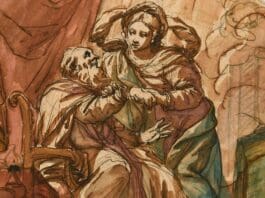
Saint John of Damascus, renowned as the last major figure among the Eastern Church fathers and its most eminent poet, has a life story shrouded in both history and legend. His biographer, John of Jerusalem, who wrote about him two centuries posthumously, blended myth with fact, blurring the lines between reality and fiction.
John hailed from a family that stood steadfast in their Christian faith even as Damascus fell to Arab rule. His forebears were not only respected by the conquerors but also held significant judicial roles, likely overseeing Christian laws for the Sultan’s Christian subjects. His father, apart from his prestigious position, amassed considerable wealth, dedicating it to freeing Christian slaves and granting them liberty. John’s birth was seen as a divine reward for these virtuous deeds, and he was baptized immediately, possibly by Peter II, Bishop of Damascus.
Keen to shield his son from the prevalent martial and piratical culture of Damascus’s youth, John’s father focused on nurturing his intellectual growth. During this era, Saracen pirates captured a monk named Cosmas. Facing execution, he was spared upon revealing his educational prowess, which prompted John’s father to free him and appoint him as John’s tutor. John rapidly absorbed all of Cosmas’s knowledge, leading Cosmas to eventually retire to the Monastery of S. Sabas.
John’s intellectual acumen earned the admiration of the Saracens, and he was reluctantly thrust into a role of greater authority than his father. As the Iconoclastic controversy intensified, John boldly opposed the Eastern Emperor, penning treatises advocating for the veneration of religious images. These writings, especially potent after Leo the Isaurian’s decree against icons in 730, swiftly spread across the Christian world.
A dramatic episode in John’s life involves a purported act of treason against Damascus, fabricated by Emperor Leo. The Sultan, believing this ruse, ordered John’s hand severed. However, a miraculous event – the restoration of his hand following prayer before an image of the Virgin Mary – convinced John of divine protection, leading him to a monastic life at the monastery of Saint Sabas.
The historical accuracy of this tale is debated, as scholarly research suggests John may have joined Saint Sabas’s monastery before the Iconoclasm controversy. During the Khalif Ahlid II’s persecution of Christians in 743, John composed an eulogy for the martyred Peter, Bishop of Majuma.
John’s life also includes a poignant anecdote where, donned in humble attire, he was sent to sell baskets in Damascus. His creative spirit was initially suppressed by the monastery’s abbot but, after composing a lament for a grieving individual, he was eventually allowed to focus on religious poetry and theological works. His hymns and defenses of Christian art and doctrine have immortalized him as “The Doctor of Christian Art.” His death date is uncertain, but it likely occurred between 754 and 787.
Photo credit: Fæ via CC BY 4.0, Wikimedia Commons
The post Saint John Damascene, Doctor of the Church appeared first on uCatholic.
Daily Reading
Day of Prayer for the Legal Protection of Unborn Children
Readings for the Day of Prayer for the Legal Protection of Unborn Children Reading 1 Hebrews 7:1-3, 15-17 Melchizedek, king of Salem and priest of God Most High, met Abraham…
Daily Meditation
Healing Our Withered Hearts
Click here for daily readings At first glance, this story is simply about Jesus healing as he does so often in the New Testament and the Pharisees clucking in disapproval….




